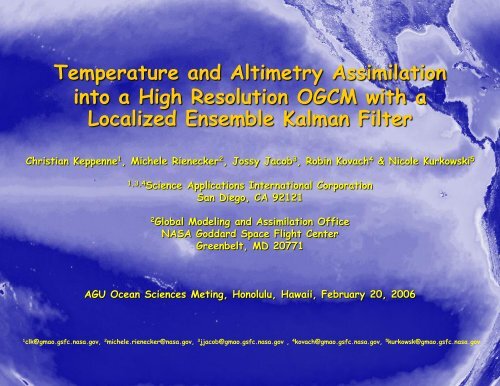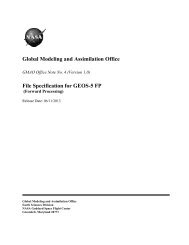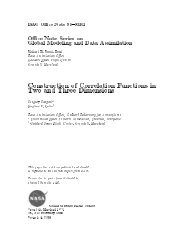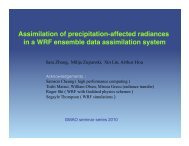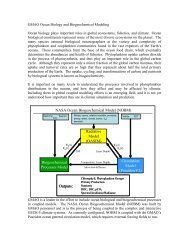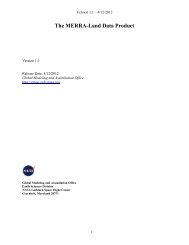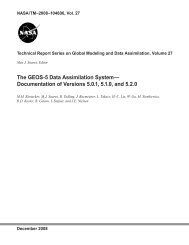Online bias estimation in SSH assimilation - NASA Global Modeling ...
Online bias estimation in SSH assimilation - NASA Global Modeling ...
Online bias estimation in SSH assimilation - NASA Global Modeling ...
Create successful ePaper yourself
Turn your PDF publications into a flip-book with our unique Google optimized e-Paper software.
Temperature and Altimetry Assimilation<br />
<strong>in</strong>to a High Resolution OGCM with a<br />
Localized Ensemble Kalman Filter<br />
Christian Keppenne 1 , Michele Rienecker 2 , Jossy Jacob 3 , Rob<strong>in</strong> Kovach 4 & Nicole Kurkowski 5<br />
1,3,4<br />
Science Applications International Corporation<br />
San Diego, CA 92121<br />
2<br />
<strong>Global</strong> Model<strong>in</strong>g and Assimilation Office<br />
<strong>NASA</strong> Goddard Space Flight Center<br />
Greenbelt, MD 20771<br />
AGU Ocean Sciences Met<strong>in</strong>g, Honolulu, Hawaii, February 20, 2006<br />
1<br />
clk@gmao.gsfc.nasa.gov, 2 michele.rienecker@nasa.gov, 3 jjacob@gmao.gsfc.nasa.gov , 4 kovach@gmao.gsfc.nasa.gov, 5 kurkowsk@gmao.gsfc.nasa.gov
Outl<strong>in</strong>e<br />
• Poseidon OGCM and GMAO coupled forecast<strong>in</strong>g system<br />
• EnKF implementation for Poseidon<br />
• Assimilation experiments<br />
• Impact of T+<strong>SSH</strong> <strong>assimilation</strong> on CGCM seasonal h<strong>in</strong>dcast skill
GMAO CGCM coupled forecast<strong>in</strong>g system<br />
- GMAO AGCM, 2 x 2.5 x L34<br />
- LSM: Mosaic (SVAT)<br />
- OGCM: Poseidon v4, 1/3 x 5/8 x L27<br />
- Production ODAS: OI of <strong>in</strong> situ temperature profiles with sal<strong>in</strong>ity adjustment<br />
- Experimental ODAS: EnKF<br />
Note: ODAS is run on OGCM prior to coupl<strong>in</strong>g to AGCM & LSM<br />
OGCM<br />
• Poseidon (Schopf and Loughe, 1995)<br />
• Quasi-isopycnal vertical coord<strong>in</strong>ate<br />
• Prognostic variables are h, t, s, u and v<br />
• Sea surface height (<strong>SSH</strong>) is diagnostic: h = S i buoyancy(t i , s i ) h i<br />
• About 30 million prognostic variables at 1/3 x 5/8 x L27 resolution<br />
CGCM and OGCM
Multivariate update<br />
• Multivariate compactly supported covariances<br />
• Update T, S, u & v<br />
• Layer thicknesses (h) adjust between analyses<br />
• Incremental update<br />
• Process <strong>SSH</strong> and T observations separately<br />
System-noise modell<strong>in</strong>g<br />
• Model errors: use model EOFs to generate state perturbations<br />
• Forc<strong>in</strong>g errors: add random perturbations to w<strong>in</strong>d stress forc<strong>in</strong>g<br />
Parallel implementation (message pass<strong>in</strong>g: MPI, SHMEM)<br />
• Runs on SGI Altix or HP SC45<br />
• Time/month on 240 Altix CPUs:<br />
• 8+1 ensemble members: 2.1 hours<br />
• 16+1 ensemble members: 3.8 hours<br />
• 32+1 ensemble members: 7 hours<br />
<strong>Onl<strong>in</strong>e</strong> <strong>bias</strong> <strong>estimation</strong><br />
• Used <strong>in</strong> <strong>SSH</strong> <strong>assimilation</strong><br />
Hybrid (3DVAR + ensemble) covariances<br />
• Used <strong>in</strong> T <strong>assimilation</strong><br />
EnKF implementation
observable<br />
observable<br />
est. <strong>bias</strong><br />
a) Standard <strong>assimilation</strong><br />
true climate<br />
Assimilation alters the<br />
model climatology<br />
model climate<br />
b) Assimilation with <strong>Onl<strong>in</strong>e</strong> <strong>bias</strong> <strong>estimation</strong> (OBE)<br />
true climate<br />
Estimates of variability (<strong>bias</strong>ed model<br />
state) and climatological error (<strong>bias</strong>)<br />
are evolved side by side<br />
model climate<br />
<strong>Onl<strong>in</strong>e</strong> <strong>bias</strong> <strong>estimation</strong>
Assimilation experiment<br />
• Assimilate T/P anomalies + TAO & XBT temperature profiles 1/1/2001-12/31/2001<br />
• <strong>Onl<strong>in</strong>e</strong> <strong>bias</strong> <strong>estimation</strong> <strong>in</strong> <strong>SSH</strong> <strong>assimilation</strong><br />
• Random forc<strong>in</strong>g from 32 OGCM lead<strong>in</strong>g EOFs + w<strong>in</strong>d-stress perturbations<br />
• Compare 9, 17 & 33 member EnKF<br />
• Compare with<br />
• no-<strong>assimilation</strong> control<br />
• Production ODAS (temperature OI + sal<strong>in</strong>ity correction)<br />
Experiments
<strong>SSH</strong> OMF and OMA statistics<br />
Control<br />
mean OMF<br />
RMS OMF<br />
mean OMA<br />
RMS OMA<br />
Note the differences <strong>in</strong> scales!<br />
OI+S(T)<br />
T OI affects <strong>SSH</strong> <strong>bias</strong> even though<br />
OI + S(T) doesn’t process <strong>SSH</strong><br />
EnKF 33<br />
Free model run climatology<br />
used to reconstruct <strong>SSH</strong><br />
field from T/P anomalies<br />
Time series<br />
EnKF9<br />
Control<br />
EnKF17<br />
• Control is most <strong>bias</strong>ed<br />
• OI partly corrects <strong>SSH</strong> <strong>bias</strong><br />
• EnKF runs have no noticeable <strong>SSH</strong> <strong>bias</strong><br />
OI+S(T)<br />
EnKF33<br />
Time averages
Control<br />
OI+S(T)<br />
T OMF and OMA statistics<br />
mean OMF<br />
RMS OMF<br />
mean OMA<br />
RMS OMA<br />
Note the differences <strong>in</strong> scales!<br />
EnKF 33<br />
T <strong>assimilation</strong> <strong>in</strong> EnKF runs uses<br />
hybrid 3DVAR + EnKF covariances<br />
Time series<br />
(Hybrid covariances used <strong>in</strong> T <strong>assimilation</strong> with EnKF result <strong>in</strong> stronger data weights than OI+S(T))<br />
Control<br />
OI+S(T)<br />
EnKF9 EnKF17 EnKF33<br />
Time averages
Zonal sections<br />
EnKF 32 - 12/31/01<br />
32 lead<strong>in</strong>g EOFs<br />
Marg<strong>in</strong>al T Kalman<br />
ga<strong>in</strong>s for a 1C<br />
<strong>in</strong>novation at two<br />
different locations<br />
Horizontal sections<br />
EnKF 32 - 12/31/01<br />
32 lead<strong>in</strong>g EOFs
EnKF 32 - 12/31/01<br />
32 lead<strong>in</strong>g EOFs<br />
Marg<strong>in</strong>al S Kalman<br />
ga<strong>in</strong>s for a 1s t T<br />
<strong>in</strong>novation at two<br />
different locations<br />
(units of s s )<br />
Horizontal sections<br />
EnKF 32 - 12/31/01<br />
32 lead<strong>in</strong>g EOFs<br />
Zonal sections
Marg<strong>in</strong>al T Kalman ga<strong>in</strong> for a unit T <strong>in</strong>novation at (125W, 0N, 100m)<br />
March 31, 2001 June 30, 2001 September 31, 2001 December 31, 2001<br />
EnKF<br />
9<br />
EnKF<br />
17<br />
EnKF<br />
33<br />
Steady state: 32 lead<strong>in</strong>g EOFs
Marg<strong>in</strong>al S Kalman ga<strong>in</strong> for a 1 s t T <strong>in</strong>novation at (125W, 0N, 100m)<br />
March 31, 2001 June 30, 2001 September 31, 2001<br />
December 31, 2001<br />
EnKF<br />
9<br />
EnKF<br />
17<br />
EnKF<br />
33<br />
• EnKF9 produces spurious covariance structures<br />
• Apparent consistency between EnKF17 & EnKF33<br />
Steady state: 32 lead<strong>in</strong>g EOFs
Impact of <strong>assimilation</strong> on CGCM h<strong>in</strong>dcast skill<br />
• Old code with <strong>assimilation</strong> <strong>in</strong> model layers: 17-member EnKF<br />
• Assimilate T + <strong>SSH</strong> for February-April of each year of 1993-2002<br />
• Couple OGCM to AGCM & LSM after runn<strong>in</strong>g ODAS<br />
• 12-month CGCM h<strong>in</strong>dcasts <strong>in</strong>itialized us<strong>in</strong>g ocean states from EnKF runs<br />
(to save CPU time, CGCM h<strong>in</strong>dcasts have only 5 ensemble member)<br />
• Assess impact of <strong>assimilation</strong> on SST h<strong>in</strong>dcast skill<br />
• Compare to history of CGCMv1 May-start h<strong>in</strong>dcasts (problematic month)
EnKF T+<strong>SSH</strong>, OBE<br />
NSIPP CGCMv1 tier 1<br />
False EN alert<br />
missed EN<br />
missed EN<br />
Niño-3.4 SST<br />
missed EN<br />
false LN alert false LN alert
Conclusions<br />
• <strong>Onl<strong>in</strong>e</strong> <strong>bias</strong> correction important when T data & <strong>SSH</strong> anomalies are assimilated.<br />
• 16+1 and 32+1 EnKF runs have comparable performance<br />
• EnKF-<strong>in</strong>itialized h<strong>in</strong>dcasts can miss or underestimate El Niño events but result <strong>in</strong><br />
less false El Niño or La Niña alerts than production forecasts


